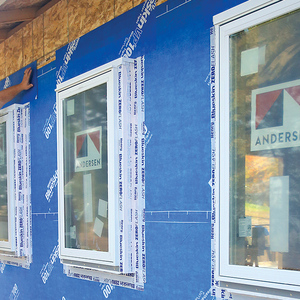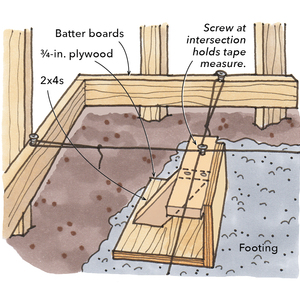I just stripped some thirty yo wallpaper from the living room, and painted it in that trendy deep red. It took FOUR COATS to get an even coverage on the walls. FOUR! Is there something about red paint that makes it give less coverage than other colors, or was something just funny here? I did paint my dining room- which was also wallpapered in the same era- with the same paint in a different color, and it only took one coat.
I’ve never had this much trouble with painting a room before. And if red paint always gives this much trouble, I won’t go that way again.
I did mess up when I put the first coat on while the walls were still a little damp from wallpaper removal.
Tom



















Replies
There's a warning on the Disney colour charts that red requires a tinted primer.
Phill Giles
The Unionville Woodwright
Unionville, Ontario
You're lucky if you even got it to be the color red you wanted in the first place. Red paint is a PITA. But worth it, if you get it right in the end.
"Our whole American way of life is a great war of ideas, and librarians are the arms dealers selling weapons to both sides."
-James Quinn
We did our bedroom in "hunting coat red" and it took 4 or 5 coats not to mention the tinted primer. We used Behr- maybe a higher grade product would have covered it in fewer coats.
Painted a garage door with Behr red paint, it was awful, never again....Next time its Tremclad red or another color :)
The paint I used was Behr as well. I tried to look and see what kind of pigment they used, and see if any extenders were added to their paint, but nothing said anything about this. The girl at the counter just kinda looked at me funny when I asked what extenders they used (read that article in the other FHB last month.) What paints are of good quality if you can't tell what a paint is made of?
Tom
PS, Thanks for the input everyone.
Benjamin Moore and Sherwin Williams are both good paints, We mostly use Benjamin Moore but that's mainly because of the service we get at their shop over SW. I think their paint lays down nicer and I also think that's all in my head so..
It's not only the brand of paint, but the type, each store will have a line of paints of different qualities. BM super-spec is good paint, Regal is their best.
CAG, kinda goes back to what was mentioned earlier......cost. Higher quality paints cost more. Even in some of the premium lines however there are problems with hiding in the dark red, blue, and green colors.
From a manufacturing/marketing point it is always a balancing act. Most tue red, green and blue pigments are organic types, and use to be five or six times more expensive than inorganic pigments like titanium dioxide (white) and iron oxides. You would think that the dark colors would have better hiding than the lighter colors, but because of pigment particle size and pigment to vehicle ratios used they don't. If they were to use enough organic red pigment to get the same volume/solid ratio as a white the cost per gallon would be off the chart. The trick in formulation is to keep the material/manufactureing cost within a certin range to make a profit. All of the product lines in a retail sales line of paint should sell for about the same $$ per gallon. To stay within those parameters the high cost dark pigments are formulated to the minimum amounts needed. Not a problem in high end products, but as you goe down the quality levels this cost control efforts results in poor product performance, i.e. hiding.
Dave
Just about any dark rich color will do this to you. I finally learned to apply a flat similiar tinted color for a base. Saved me a couple of coats.
I had a job to paint a room in an egglpant flourescent color years ago. Finally after 5 coats it covered. There other room was a flourescent orange. It covered better but I lost my eyesight for a while.
The color choices were my fault, I encouraged the client to fullfill her fantasy. Told her it's just paint and that we could always paint it over if she didn't like it. I had know idea these were her color ideas.
She changed her mind on the eggplant room and it took 3 coats of killz and two coats of white to get it back. She liked the orange tho go figure.
Bob the Enabler
Rustoleum seems to cover well with 2 coats. Don't know why exactly. Most every other red doesn't cover as well. The pigment I suppose. Auto body primer also covers well. Those use iron oxide pigments. I don't know what they use in a latex paint.
You said the walls were still wet from the paper removal, did you prime/seal them first? If not the first coat could be chalked up to that.
Other then that red paint is a PITA, I've had the success with tinting the primer a darkish pink color, someone suggested using black primer before and swore by it here.
What color did you paint the other walls with that only took one coat? In most cases you can get by with a light colored paint in one coat, but if you get real close to the wall you can see a second coat would have helped solidify the finish.
What Brand and type of paint did you use?
Red pigments (true reds) are expensive. The iron oxides, both red abd yellow, are a lot cheaper and help produce a more durable film.
In product developement of paint, film thicknes and hiding are constantly be balanced agianst one another. Many red paints just plane don't have enough of the colored pigment to get good hiding at the applied film thickness. Part of that is because of the small particle size of the red pigment and its tendency to add body to the wet film. The product appears to have the same thickness and properties as an off white of the same manufactures, but when it is rolled out it is actually going on much thinner. If I remember correcttly the characteristic of such pigments is called thicksotropic (sp?). Most of the time it is not a problem because dark colors are usussally just accent or trim colors and applied with a brush, so the film thickness is greater and the thicksotropic character is not a problem. Rolling it out adds enough movement to the liquid paint to break up this property of the paint. This movement is akin to reducing the viscosity of the paint and causes thin film application.
That is what I remember of red paints from my years working in a product developement paint lab sooooo many years ago.
Dave
The Walls were not 'wet' We let them dry out for a day and a half, and we put down white kilz over it before we painted. The paint we used was Behr Premium plus flat enamel. The wall that covered in one coat was a peach color.
Tom
I painted a foyer for a client a few years back with a deep red paint from Sherwin-Williams. It took seven coats to cover, and there were still places that I didn't think looked that good.
I had the chance to use the same color a year or two later for another client. I painted the walls flat black to start and got great coverage in three coats when I put the red on.
To borrow someone else's tag line. Your mileage may vary.
That's normal with deep red paint, as well as most deep colors. The reason is the way deep colors are pigmented.
Most paints are light colors and contain opacifiers. This is usually titanium dioxide in the better quality paints, sometimes cheaper materials in the low end paints. These materials are basically finely divided powders, and they are white. They block extremely well. In the deeper colors, however, they can't be used because they would turn the paint lighter, for example, you couldn't get a deep red, it would be pink. So, deep colors are colored usually with dyes. Since dyes don't contain powders, they can't hide nearly as well.
I suspect (but never tried it), that if you put on a coat of something like barn red which may contain iron oxide powder, it would cover the light wall, then you'd need fewer coats of the final color to cover.
red requires a tinted primer, and takes about two coats possibly three.
For red, use a gray-tinted primer.
Your paint saleman should have given you a heads up on that.
Still, three evenly rolled coats still seems to be the minimum for full, rich, coverage. Occasionally four if brushing and trying for a mottled finish.
Damn ...
I scroll to the end ... all excited ... then someone stole my thunder!
dammit ...
my painter tipped me off about a year or so ago ....
turned a room a deep dark beautiful red in one grey primer coat and 2 regular top coats.
One top mighta even done it .... but we contracted for 2...
and he's an honest sort of guy.
JeffBuck Construction Pittsburgh,PA
Fine Carpentery.....While U Waite
Wow, and I thought yellow was bad. I can't remember how many coats it took to get the true color to come thru on the back door after the DW picked out a nice bright yellow. I thought the white undercoat was going to help, but no such luck. Still looks good tho, a decade later.
Grey primer works for yellow and magenta too - for blues, tint the same colour as you top coat..
Phill Giles
The Unionville Woodwright
Unionville, Ontario
<minor diversion>
Guess what, Jeff...Corsendonk is now one of my wife's favorites.
<back to business>
what a coincidence....
it's now one of mine too!
and I'm pretty sure I can get it local too ......
have you tried that Scottish brew I mentioned? Traquair .... if U haven't had ... I think ya might like it ... tasted some similar in the tour of Belgium you sent.
it's a merchant du vin import ....I can get half cases (24 11oz. bottles) for around $45.
Back to your regularly scheduled programing .....
Jeff
Buck Construction Pittsburgh,PA
Fine Carpentery.....While U Waite
Primer for sure, first, and grey is particularly good (I tinted some KillZ to a pink, but would up using 3 coats of S-W A400 to cover). The A400 is supoosed to be "self priming," but with dark colors, a solid primer underneath is still the best way to go.